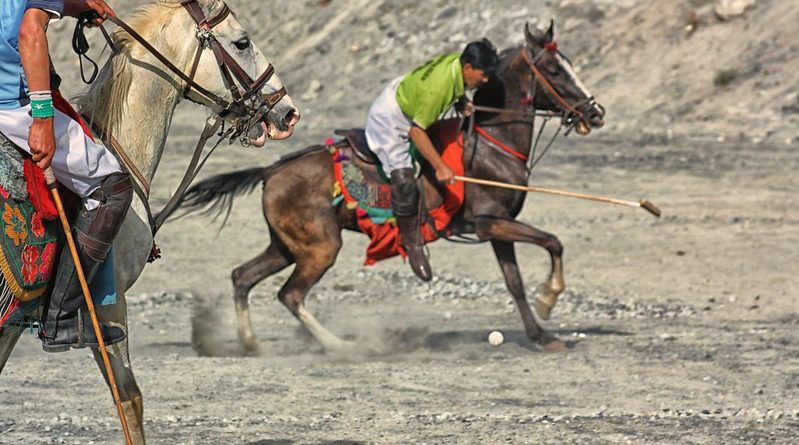Between Heaven and Hell: Polo in Pakistan
Culture Facts
Where: Northern Areas of Pakistan
When: The Shandur Pass Tournament, annually in June
History: Ancient Persian military training adopted by British colonialists
What Happens: 12 man battle hell on ponyback – a violent and bloody croquet high on a dangerous moutain ridge
The man voted by his countrymen as ‘the greatest ever Briton’ (BBC Poll, 2002), Winston Churchill, once said that “A polo handicap is your passport to the world”.
His words could not ring with more shattering truth than in Northern Pakistan where Polo is truly the national sport, favoured even over cricket and one in which people of all classes participate. The government support the high cost of polo tournaments, making it one of the few activities in Pakistani which is truly open to all.
History of Polo
Polo is one of the oldest sports in the world. It combines the skills of the rider with the power of the horse as well as team tactics. It is played in 48 countries in 5 continents. The ancient grounds of polo stretched from Constantinople (Istanbul) to Japan during the Middle Ages. It was begun several thousand years ago as military training for the elite Sultan’s army – possibly from Persia, although Pakistanis and Indians believe it originates from the Northern Areas. The very name ‘polo’ is the Balti term for ball. The original teams would have been armies with dozens on each side, ready to do battle. During the world’s first tournament in 600BC the Turks thrashed the Persians and the battle has continued on to this day.
The first written rules of modern Polo were created by an Irishman, Captain John Watson in 1874, where the ‘offside’ rule was set in stone but little understood! It was around this time that Polo was brought to the West after military colonialists discovered the game in India and it soon became a firm favourite with the aristocracy. The British Raj formed the oldest active club in the world in Calcutta. Although dropped from the official games since World War I, polo is now back on the menu as an Olympic sport. The leaders in the field are currently Argentina, the USA and England.
Rules of Polo
Each team has six player, six ponies, six mallets and one ball between the two teams. The opposing team charge their rivals and at the half way line try and score into the opposition’s goal. There is much hanging off the side of the pony, smacking together of mallets and general misdemeanor. Imagine croquet on horseback without the tea and scones. The game is oven when one team reaches nine goals, although modern games are more often two sides of 30 minutes.
If you’re now imagining England’s Prince Charles poncing about on a horse, think again, Pakistani Polo is the real deal, aggressive, fiery and fast paced – no ‘niceties’.
Let the Battle Commence!
A polo legend from ancient North Pakistan was that a king begged the gods to return his missing wife. The gods said they would do this, but only on the condition that he sacrifice his two sons. They gave him a powerful horse, so fast it split valleys in two on its flight to Baltistan. He smacked the heads of his sacrificed sons in to the opening in the mountain in order to reclaim his queen. Near Kaphulu, you can see an opening in a mountain and a real polo field where gory scenes are periodically carried out in the name of the sport. Animal heads have been used in the past as well as the severed heads of the enemies of Genghis Khan! The animals aren’t the only casualty in the wild Indian style of play – even in officious matches players will try and thwack the shoulders and arms of their opponents. Half time is less slices of oranges and more time for splints and bandages. A handicap in Indian Polo can have quite an unpleasant connotation.
Where to See a Polo Match
The best play to see a game of polo is the Northern Areas of Pakistan or Chitral. Key tournaments of the season are the Uprising Day tournament in early November in Gilgit, or thePakistan Independence Day tournament in Skardu, early August.
Polo Between Heaven and Hell
The greatest and most infamous polo tournaments, however, takes places annually on theShandur Pass, the highest polo ground in the world where a Chitral vs Gilgit tournament is held every June. The rules of the game here date back 800 years to those created by a descendent of Genghis Khan himself. The competition was created in the 1920s to promote integration between the various tribes and the British rulers. The Shandur Pass was picked as the location because, at 11,000ft above sea level, it was seen as a ridge between heaven and hell. The loose rules practiced are, however, more likely to lead to total anarchy than integration and every year players faced injury and even death during the tournament.
Its no casual sightseeing affair – to even get to this ground you face a 13 hour drive from Gilgit along a treachourously dangerous and narrow mountain pass where you risk possible death if you meet another jeep on the other side of the Pass! Even the ponies face a 5 day trek before the match. All in all, the fatalities are high before the match has even began, although around 10,000 extremists are prepared to make the trek out to Shandur every year. Violence, tension and corruption are all in play – and that’s just off the pitch.
More Information
Polo at Sandur Pass – Half-Way to Heaven
A bizaare and macabre tale of gore, daredevilry and polo in the high ridges of Northern Pakistan.
By Susi O’Neill




